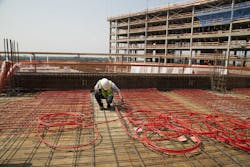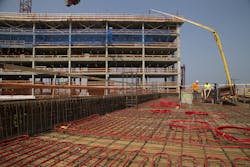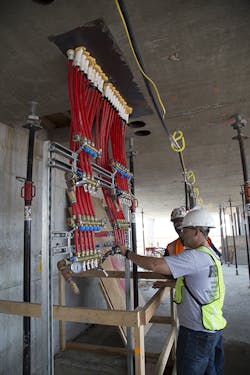Tour any college campus with a prospective incoming student and you’ll be shown the facilities where students spend time outside of the classroom as much as you will see lecture halls and laboratories. And for good reason – student life on campus today is about the whole experience, including time spent exercising, socializing, sleeping and eating. In today’s college life, dining halls and rock walls are as important as chemistry labs and tutoring centers.
Administrators at the University of Chicago recognized this fact as they developed plans for the Campus North Residential Commons, a 400,000 sq. ft. (37,161 m2) facility that would replace Pierce Tower Residence Hall and Dining Commons, which housed students for more than 50 years before it was demolished in 2013.
School administrators embraced the opportunity to build an innovative facility that students would be happy to call home. Their goal was to create a modern, energy-efficient structure that would bridge the academic community with the surrounding neighborhood of Hyde Park.
Kevin Rodgers, the university’s campus energy manager, worked with energy specialists at the National Renewable Energy Laboratory to set an aggressive energy-saving target for the new residence hall. They landed on a target annual energy usage intensity (EUI) of 56.6 kBtu/ft2. (EUI is defined as the total amount of energy used by a building per year divided by its total gross floor area.) The University of Chicago has pursued energy efficiency across campus for years, but Rodgers says this is the first building project to include a specific energy goal as part of the RFP.
Compared to the average residence hall usage in Chicago, this EUI represents a 41% reduction, eliminating 1,920 metric tons of CO2 emissions per year. Rodgers indicates that Pierce Hall had an annual EUI of 150 kBtu/sq. ft., nearly three times the target for the new structure, while the average university residence hall building in Chicago had an EUI of 96.6 kBtu/sq. ft. per year in 2016 based on real data provided by five area universities.
Unique design meets energy targets
Architectural firm Studio Gang and general contractor Mortenson Construction were awarded the design-build partnership, following an intensive multi-stage competition. “There were some concerns going in that the aggressive energy goals we established would result in rectangle boxes instead of architecturally significant buildings,” Rodgers says. “That ended up being false. The four finalists all had very unique designs that met our energy requirements.”
Studio Gang’s design features eight “houses,” each accommodating approximately 100 students. The college houses are structured around a three-story hub that includes shared space for students, a study room, a kitchen and a dining area. The student-only second level contains the group study rooms, recreation rooms, music rooms and two community commons, plus lounge-like hangout spaces with a fireplace, each serving 400 students (or four houses). The first level features retail and restaurant space, offices, classrooms and a dining commons that is open to the public and the campus at large.
The new residence hall offers a variety of living options, providing floors that are a mix of single and double rooms close to the hubs for underclassmen and apartment-style rooms that have private rooms and kitchen facilities for upperclassmen. The residential volumes’ shape, size and positioning are “tuned” to maximize free energy from the sun and wind while minimizing heating and cooling consumption.
The building’s common areas are heated via a traditional forced-air system, while the student living quarters use in-slab hydronic radiant heating and cooling. Todd Zima, design principal at Studio Gang, says the radiant heating and cooling system was chosen early in the project for the dorm rooms in order to improve energy efficiency and enhance comfort for the students. By circulating heated or chilled water through 5/8" REHAU PEXa pipe installed in the ceilings on each floor, the hydronic system maintains the spaces at even, comfortable temperatures while using less energy than traditional forced-air systems.
“To include radiant cooling in a project of this size in this climate for a residential structure was something we hadn’t seen,” Zima says. Sharing the capabilities of the radiant system with Mortenson Construction and university officials convinced them it was the way to go.
Collaborative planning enables tight timeline
Energy targets were not the only ambitious component of the project. Mortenson Construction set an aggressive schedule to have the residence hall ready by the start of the 2016-2017 school year. Installing sufficient square footage of radiant heating and cooling pipe at the pace required to meet Mortenson’s schedule required some ingenuity.
Ryan Blackman, project manager at Chicago-based Mechanical Inc., says participation by his company and REHAU early in the planning stages helped them meet the tight deadlines that would come later. Blackman’s team worked with dbHMS and Studio Gang a year before construction began to “determine how the building would actually be built.”
Mechanical, Inc. was the mechanical contractor, with the scope of their work including the radiant/ HVACR system, and O’Sullivan Plumbing in charge of domestic water/wastewater systems. Mechanical, Inc. has been in business since 1968, specializing in larger institutional/industrial applications. The company employs roughly 600 full-time equivalents, working anywhere from 80 to 100 jobs in the course of a year.
Partnering early led Mechanical, Inc. to preassemble each room’s radiant heating/cooling system on metal rod mesh mats on the ground. A floor’s worth of mats were then stacked and lifted by crane on a custom-built platform to each tower for speedy installation.
“We thought outside the box a fair amount, and, to be honest, we surprised ourselves,” Blackman says. “The first couple of floors were a bit of a learning curve, but once we got into a groove of the entire fabrication process, we were able to meet Mortenson’s schedule and put in a quality product. It ended up going very well.”
Blackman credited REHAU team members for their flexibility and innovative ideas. “I can’t tell you how many conference calls and site visits we had. They were great. They went through a lot of revisions, both for design issues, as well as constructability issues,” he says.
“We brought them in early because they had been working with dbHMS on how everything was going to be laid out. Then, we brought them in to consult on how the system would come together and what the construction limits were. A lot of times, when we don’t have this opportunity to participate early on in projects, things get drawn up that we as contractors can’t make work. Our front-end work on this project kept us from holding up construction on the job.”
Mechanical, Inc. installed more than 450,000 linear feet of PEXa tubing. Powering the entire system are three, six-million BTU AERCO high-efficiency condensing boilers with a turndown ratio of 15:1.
Each of the 24 floors included eight REHAU Pro-Balance manifolds. With anywhere from three to six zones on each manifold, the total project included something between 900 and 1,000 separate zones, granting building managers and occupants and incredible degree of control.
Grundfos circulators keep the radiant fluid in motion – although “circulators” may not be the right word for pumps that are in some cases moving 910 GPM.
Other key aspects of the project include:
• Building system controls linked to meters that record energy use and system performance
• Window sensors that detect when windows are open, turning off the room’s flow of water to save energy and react to varying humidity
• Sensors embedded in the slab that signal the manifold to provide hot or cold water to each room, providing continuous comfort while saving energy
One of the benefits of all this technology, according to dbHMS Principal Sachin Anand, is that students don’t have to use thermostats. The floors are divided into four zones, each with two sensors that adjust the radiant ceiling slab temperature dynamically depending on the outside temperature, the solar radiation and the orientation of the zone.
Detailed energy use measurement for a full year following completion is built into the RFP to ensure the building hits performance targets. Rodgers says it will take a full year of measuring energy usage and fine-tuning settings before the building reaches maximum performance, but early readings are encouraging. The project has also been submitted for LEED certification.
The editor would like to thank Larry Voss, Project Executive, Mechanical, Inc,. for contributing additional details to this article.


